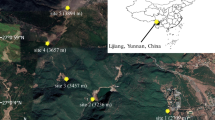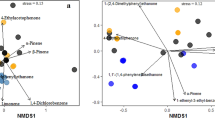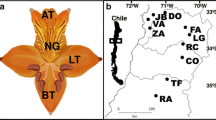Abstract
Plants growing along steep elevational gradients experience variations in abiotic conditions. The elevational gradient also affects the diversity and abundance of pollinators associated with these plants. As a result, plants may have locally adapted floral traits. However, detailed assessments of multiple floral traits along elevational gradients are often neglected despite the traits being important for plant sexual reproduction. We tested the association of floral traits with pollinators in response to elevation by identifying pollinators and measuring morphological and biochemical floral traits as well as studying the breeding systems of ten aggregated Rhododendron species in the Sikkim Himalaya. Corolla length, nectar volume and distance between stamen and stigma significantly decreased with elevation. In contrast, nectar concentrations were positively associated with elevation. Birds, bumblebees and flies were the three dominant pollinator groups. Bird visits showed a strong negative association with elevation while visits by bumblebees and flies increased with elevation. Species with longer corollas and higher nectar volumes showed higher rates of bird visits, while bumblebees were associated with species that had higher nectar concentrations. Fruit set following cross-pollination was high compared to self-pollination, and higher pollen limitation and auto-fertility were observed among species in higher elevations. These observed patterns in the association between floral traits and pollinator groups in response to elevation may help generate testable hypotheses on alpine plant–pollinator responses to climate warming.






Similar content being viewed by others
References
Baker HG, Baker I (1990) The predictive value of nectar chemistry to the recognition of pollinator types. Israel J Bot 39:157–166. https://doi.org/10.1080/0021213X.1990.10677140
Baker HG, Baker I, Hodges SA (1998) Sugar composition of nectars and fruits consumed by birds and bats in the tropics and subtropics 1. Biotropica 30:559–586. https://doi.org/10.1111/j.1744-7429.1998.tb00097.x
Basnett S, Nagaraju SK, Gudasalamani R, Devy S (2019) Influence of phylogeny and abiotic factors varies across early and late reproductive phenology of Himalayan Rhododendrons. Ecosphere 10:e02581. https://doi.org/10.1002/ecs2.2581
Bates D, Maechler M, Bolker B (2011) lme4: Linear mixed-effects models using S4 classes http://CRAN.R-project.org/package-lme4. Accessed 2013
Behera MD, Kushwaha SPS, Roy PS (2002) High plant endemism in an Indian hotspot—Eastern Himalaya. Biodivers Conserv 11:669–682. https://doi.org/10.1023/A:1015596309833
Bergamo PJ, Telles FJ, Arnold SEJ, Brito VLG (2018) Flower color within communities shifts from overdispersed to clustered along an alpine altitudinal gradient. Oecologia 1-13. https://doi.org/10.1007/s00442-018-4204-5
Bingham RA, Orthner AR (1998) Efficient pollination of alpine plants. Nature 391:238–239
Bolten AB, Feinsinger P (1978) Why do hummingbird flowers secrete dilute nectar? Biotropica 10:307–309. https://doi.org/10.2307/2387684
Bray JR, Curtis JT (1957) An ordination of the upland forest communities of southern Wisconsin. Ecol Monogr 27:325–349. https://doi.org/10.2307/1942268
Brunet J (2009) Pollinators of the Rocky Mountain columbine: temporal variation, functional groups and associations with floral traits. Ann Bot 103:1567–1578. https://doi.org/10.1093/aob/mcp096
Chamberlain D, Hyam R, Argent G, Fairweather G, Walter KS (1996) The genus Rhododendron: its classification and synonymy. Royal Botanic Garden Edinburgh, Edinburgh
Crawford RMM (1989) Studies in plant survival: ecological case histories of plant adaptation to adversity. Blackwell Scientific Publications, Oxford
Dormann CF, Elith J, Bacher S et al (2013) Collinearity: a review of methods to deal with it and a simulation study evaluating their performance. Ecography 36:27–46. https://doi.org/10.1111/j.1600-0587.2012.07348.x
Escaravage N, Pornon A, Doche B, TillBottraud I (1997) Breeding system in an alpine species: Rhododendron ferrugineum L (Ericaceae) in the French northern Alps. Can J Bot 75:736–743. https://doi.org/10.1139/b97-084
Fabbro T, Körner C (2004) Altitudinal differences in flower traits and reproductive allocation. Flora 199:70–81. https://doi.org/10.1078/0367-2530-00128
Fenster CB, Armbruster WS, Wilson P et al (2004) Pollination syndromes and floral specialization. Annu Rev Ecol Evol Syst 35:375–403. https://doi.org/10.2307/annurev.ecolsys.34.011802.30000015
Georgian E, Fang Z, Emshwiller E, Pidgeon A (2015) The Pollination Ecology of Rhododendron Floccigerum Franchet (Ericaceae) in Weixi, Yunnan Province, China. J Pollinat Ecol 16:72–81. https://doi.org/10.3896/IBRA.1.52.4.12
Grierson AJC, Long DG (1983) Flora of Bhutan, vol 2. Royal Botanical Garden, Edinburgh
Grytnes JA, Vetaas OR (2002) Species richness and elevation: a comparison between null models and interpolated plant species richness along the Himalayan altitudinal gradient, Nepal. Am Nat 159:294–304. https://doi.org/10.1086/338542
Guo H, Mazer SJ, Du G (2010) Geographic variation in seed mass within and among nine species of Pedicularis (Orobanchaceae): effects of elevation, plant size and seed number per fruit. J Ecol 98:1232–1242. https://doi.org/10.1111/j.1365-2745.2010.01688.x
Gurung P, Jayashree G, Uma R (2018) Facilitative interactions among co-flowering Primula species mediated by pollinator sharing. Plant Ecol 219:1159–1168. https://doi.org/10.1007/s11258-018-0868-5
Hart R, Georgian EM, Salick J (2016) Fast and cheap in the fall: phylogenetic determinants of late flowering phenologies in Himalayan Rhododendron. Am J Bot 103:198–206. https://doi.org/10.3732/ajb.1500440
Hegland SJ, Totland Ø (2005) Relationships between species’ floral traits and pollinator visitation in a temperate grassland. Oecologia 145:586–594. https://doi.org/10.1007/s00442-005-0165-6
Hill PSM, Hollis J, Wells H (2001) Foraging decisions in nectarivores: unexpected interactions between flower constancy and energetic rewards. Anim Behav 62:729–737. https://doi.org/10.1006/anbe.2001.1775
Huang ZH, Song YP, Huang SQ (2017) Evidence for passerine bird pollination in Rhododendron species. AoB Plants 9:1–10. https://doi.org/10.1093/aobpla/plx062
Johnson SD, Nicolson SW (2008) Evolutionary associations between nectar properties and specificity in bird pollination systems. Biol Lett 4:49–52. https://doi.org/10.1098/rsbl.2007.0496
Junker RR, Larue-Kontić AAC (2018) Elevation predicts the functional composition of alpine plant communities based on vegetative traits, but not based on floral traits. Alp Bot 128:13–22. https://doi.org/10.1007/s00035-017-0198-6
Junker RR, Blüthgen N, Brehm T, Binkenstein J, Paulus J, Schaefer HM, Stang M (2013) Specialization on traits as basis for the niche-breadth of flower visitors and as structuring mechanism of ecological networks. Funct Ecol 27:329–341. https://doi.org/10.1111/1365-2435.12005
Kazmierczak K, Perlo BV (2000) A field guide to the birds of India. Om International Publishers, India
Kiełtyk P (2018) Variation of vegetative and floral traits in the alpine plant Solidago minuta: evidence for local optimum along an elevational gradient. Alp Bot 128:47–57. https://doi.org/10.1007/s00035-017-0197-7
Körner C (1999) Alpine plant life: functional plant ecology of high mountain ecosystems. Springer, Berlin
Körner Ch (2007) The use of ‘altitude’ in ecological research. Trends Ecol Evol 22:569–574. https://doi.org/10.1016/j.tree.2007.09.006
Körner C, Paulsen J (2009) Exploring and explaining mountain biodiversity. Data mining for global trends in mountain biodiversity. CRC Press, Boca Raton
Kudo G (1993) Relationships between flowering time and fruit set of the entomophilous alpine shrub, Rhododendron aureum (Ericaceae). Am J Bot 80:1300–1304. https://doi.org/10.1002/j.1537-2197.1993.tb15368.x
Kudo G (2016) Landscape Structure of Flowering Phenology in Alpine Ecosystems: Significance of Plant-Pollinator Interactions and Evolutionary Aspects. In: Kudo G (ed) Structure and Function of Mountain Ecosystems in Japan. Springer, Tokyo
Kudo G, Hirao AS, Kawai Y (2011) Pollination Efficiency of Bumblebee Queens and Workers in the Alpine Shrub Rhododendron aureum. Int J Plant Sci 172:70–77. https://doi.org/10.1086/657282
Kumar P (2012) Assessment of impact of climate change on Rhododendrons in Sikkim Himalayas using Maxent modelling: limitations and challenges. Biodivers Conserv 21:1251–1266. https://doi.org/10.1007/s10531-012-0279-1
Larson BM, Barrett SC (2000) A comparative analysis of pollen limitation in flowering plants. Biol J Linn Soc 69:503–520. https://doi.org/10.1111/j.1095-8312.2000.tb01221.x
Lefebvre V, Villemant C, Fontaine C, Daugeron C (2018) Altitudinal, temporal and trophic partitioning of flower-visitors in Alpine communities. Sci Rep 8:1–12. https://doi.org/10.1038/s41598-018-23210-y
Legendre P, Legendre L (1998) Numerical Ecology. Elsevier, Amsterdam
Lloyd G, Schoen J (1992) Self- and Cross-fertilization in plants. I. Functional dimensions. Int J Plant Sci 153:358–369. https://doi.org/10.1086/297040
Martén-Rodríguez S, Almarales-Castro A, Fenster CB (2009) Evaluation of pollination syndromes in Antillean Gesneriaceae: evidence for bat, hummingbird and generalized flowers. J Ecol 97:348–359. https://doi.org/10.1111/j.1365-2745.2008.01465.x
McCune B, Mefford MJ (2006) PC-ORD. Multivariate analysis of ecological data. Version 5.10MjMSoftware, Gleneden Beach, Oregon. http://home.centurytel.net/*mjm/pcordwin.htm. Accessed 05 May 2012
Myers N, Mittermeier RA, Mittermeier CG, Da Fonseca GA, Kent J (2000) Biodiversity hotspots for conservation priorities. Nature 403:853–858. https://doi.org/10.1038/35002501
Ng SC, Corlett RT (2000) Comparative reproductive biology of the six species of Rhododendron (Ericaceae) in Hong Kong, South China. Can J Bot 78:221–229. https://doi.org/10.1139/cjb-78-2-221
Oksanen J, Blanchet FG, Kindt R, Legendre P, Minchin PR, 0 Hara RB, Simpson GL et al (2013) Vegan: Community Ecology Package. R package version 2.0-4. http://CRAN.R-project.org/package=vegan. Accessed Sept 2016
Orford KA, Vaughan IP, Memmott J (2015) The forgotten flies: the importance of non–syrphid Diptera as pollinators. Proc R Soc Lond B Biol Sci 282:20142934. https://doi.org/10.1098/rspb.2014.2934
Parmesan C (2006) Ecological and evolutionary responses to recent climate change. Annu Rev Ecol Evol Syst 37:637–669. https://doi.org/10.1146/annurev.ecolsys.37.091305.110100
Peeters L, Totland Ø (1999) Wind to insect pollination ratios and floral traits in five alpine Salix species. Can J Bot 1999:556–563. https://doi.org/10.1139/b99-003
Pradhan KC (2010) The Rhododendrons of Sikkim: Handbook. Sikkim adventure, Gangtok
R Core Team (2014) R: a language and environment for statistical computing. R Foundation for Statistical Computing, Vienna, Austria. http://www.R-project.org
Revelle W (2011) An overview of the psych package. Department of Psychology Northwestern University, Illinois
Shrestha M, Dyer AG, Bhattarai P, Burd M (2014) Flower colour and phylogeny along an altitudinal gradient in the Himalayas of Nepal. J Ecol 102:126–135. https://doi.org/10.1111/1365-2745.12185
Singh KK, Rai LK, Gurung B (2009) Conservation of Rhododendrons in Sikkim Himalaya: an overview. WJAS 5:284–296. http://citeseerx.ist.psu.edu/viewdoc/summary?doi=10.1.1.415.3958
Skidmore P (1985) The biology of the Muscidae of the world. Springer Science and Business Media, Dordrecht
Song YP, Huang ZH, Huang SQ (2019) Pollen aggregation by viscin threads in Rhododendron varies with pollinator. New Phytol 221:1150–1159. https://doi.org/10.1111/nph.15391
Stöcklin J, Armbruster GFJ (2016) Environmental filtering, not local adaptation of established plants, determines the occurrence of seed- and bulbil-producing Poa alpina in a local flora. Basic Appl Ecol 17:586–595. https://doi.org/10.1016/j.baae.2016.06.004
Stout JC (2007) Pollination of invasive Rhododendron ponticum (Ericaceae) in Ireland. Apidologie 38:198–206. https://doi.org/10.1051/apido
Subba B, Sen S, Ravikanth G, Peter M (2018) Direct modelling of limited migration improves projected distributions of Himalayan amphibians under climate change. Biol Conserv 227:352–360. https://doi.org/10.1016/j.biocon.2018.09.035
Takkis K, Tscheulin T, Tsalkatis P, Petanidou T (2015) Climate change reduces nectar secretion in two common Mediterranean plants. AoB Plants 7:111. https://doi.org/10.1093/aobpla/plv111
Telwala Y, Brook BW, Manish K, Pandit MK (2013) Climate-induced elevational range shifts and increase in plant species richness in a himalayan biodiversity epicentre. PLoS One 8:e57103. https://doi.org/10.1371/journal.pone.0057103
Tiusanen M, Hebert PD, Schmidt NM, Roslin T (2016) One fly to rule them all-muscid flies are the key pollinators in the Arctic. Proc R Soc Lond B Biol Sci 283:20161271. https://doi.org/10.1098/rspb.2016.1271
Totland Ø (1994) Influence of climate, time of day and season, and flower density on insect flower visitation in alpine Norway. Arct Alp Res 26:66–71. https://doi.org/10.1080/00040851.1994.12003041
Trunschke J, Stocklin J (2017) Plasticity of flower longevity in alpine plants is increased in populations from high elevation compared to low elevation populations. Alp Bot 127:41–51. https://doi.org/10.1007/s00035-016-0176-4
Williams PH, Ito M, Matsumura T, Kudo I (2010) The bumblebees of the Nepal Himalaya (Hymenoptera: Apidae). Insecta Matsumurana 66:115–151. http://hdl.handle.net/2115/44628
Willmer P (2011) Pollination and floral ecology. Princeton University Press, New Jersey
Wu ZY, Raven PH, Hong DY (2005) Flora of China, vol 14. Missouri Botanical Garden Press, Saint Louis
Acknowledgements
This research was funded by the Department of Biotechnology, Government of India (Grant No. BT/01/NE/PS/NCBS/09) and National Mission on Himalayan Studies, and implemented by the Ministry of Environment, Forest & Climate Change of India (Grant No. GBPI/NMHS/HF/RA/2015-2016). We thank the Sikkim State Department of Forests and Wildlife, Sikkim Police Department and Indian Army for research permits and logistical support. We thank Saini Mallikat, Aaarti Pannure, Yeshwanth H, Vasuki Belavadi, Kumar Ghorpade and Seena Narayanan for insect identifications. Rakesh Basnett helped with some part of the field work. Sonam Bhutia provided assistance for the data collection throughout the field work. We thank Gaku Kudo and Shoko Shakai for their valuable comments on the analysis. We are very thankful to three anonymous reviewers whose comments have vastly improved the manuscript.
Author information
Authors and Affiliations
Corresponding author
Ethics declarations
Conflict of interest
The authors declare that they have no conflict of interest.
Declaration of authorship
SB and SD conceived and designed the research. SB carried out the field work, analyzed the data and wrote the manuscript. All authors contributed to writing and approved the manuscript.
Additional information
Publisher's Note
Springer Nature remains neutral with regard to jurisdictional claims in published maps and institutional affiliations.
Electronic supplementary material
Below is the link to the electronic supplementary material.
Rights and permissions
About this article
Cite this article
Basnett, S., Ganesan, R. & Devy, S.M. Floral traits determine pollinator visitation in Rhododendron species across an elevation gradient in the Sikkim Himalaya. Alp Botany 129, 81–94 (2019). https://doi.org/10.1007/s00035-019-00225-3
Received:
Accepted:
Published:
Issue Date:
DOI: https://doi.org/10.1007/s00035-019-00225-3




